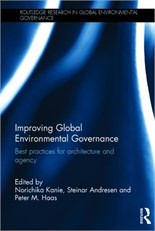Authors
Norichika Kanie, Steinar Andresen & Peter M. Haas
Publication Year
2014
Source
Routledge Publishing Elgar Publishing Ltd
280 pages
Series
Routledge Research in Global Environmental Governance
Series Editor: Philipp Pattberg, Agni Kalfagianni
By addressing key questions in this important area, the book provides new perspectives in the nexus between agency and architecture in environmental governance in the twenty-first century.
| TABLE OF CONTENTS |
List of Illustrations
List of Contributors
Preface
1. Introduction: Pluralistic Actor Configurations and International Environmental Governance: Best and Worst Practices for Improving Environmental Governance
Peter M. Haas, Steinar Andresen and Norichika Kanie
2. The Agenda Setting at Sea and in the Air
Stacy D. VanDeveer
3. Lessons Learned in Multilateral Environmental Negotiations
Pamela S. Chasek
4. Actor Configurations and Compliance Tasks in International Environmental Governance
Olav Schram Stokke
5. The Mismatch of Implementation Networks in International Environmental Regimes: Lessons from Different Agreements
Jose Antonio Puppim de Oliveira
6. Resilience and Biodiversity Governance: The Processes of Actor Configurations which Support and Limit Resilience
Casey Stevens
7. Governance Components in Private Regulation: Implications for Legitimacy, Authority and Effectiveness
Graeme Auld, Benjamin Cashore and Stefan Renckens
8. Actor Configurations in the Climate Regime: The States Call the Shots
Steinar Andresen, Norichika Kanie and Peter M. Haas
9. Conclusion: Lessons from Pluralistic Green Governance
Norichika Kanie, Peter M. Haas and Steinar Andresen
Annex: Outline of Regimes Covered in this Volume
Masahiko Iguchi
Index
About the author

Steinar Andresen
Senior Research Fellow, Fridtjof Nansen Institute, Norway

Peter M. Haas
Professor of Political Science, University of Massachusetts Amherst, Department of Political Science, USA

Norichika Kanie
Associate Professor at the Tokyo Institute of Technology, Japan, and a Research Fellow at the United Nations University Institute of Advanced Studies.



